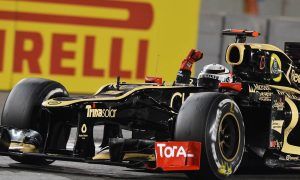HONDA – A RADICAL, YET RESTRICTIVE DESIGN?
Like Mercedes, Honda has split its turbocharger. But the Japanese manufacturer has been much more radical in its overall approach. On last year’s RA615H the compressor, turbine, and MGU-H had all been downsized to fit within the ‘Vee’ of the engine. Again, a smaller turbine generates less power than a bigger one, so the MGU-H absorbs less power from the turbine shaft as a result.
This radical downsizing and the associated restraints were decided and agreed in accordance with McLaren ahead of the partners’ reunion. Speaking to the press on the opening 2015 pre-season test in Jerez, Woking boss Ron Dennis went into details to present the aggressive-looking MP4-30 package.
“The engine is an integral part of our 'size zero' philosophy. The car is phenomenally tightly packaged in the back end,” he said at the time.
“[McLaren chief engineer] Peter Prodromou and his team, I have to say, have taken full advantage of the level of detailing and the precision of manufacturing of the components has surpassed any McLaren standards of the past.
“The elegance of some of the aero solutions, as they are packaged into the suspension, brake ducts and all of these things, we think are to the level that we have never been able to achieve before.
“If you are behind in any sport, catching requires you to accelerate faster than they are running, otherwise you will not catch them up. Have we taken some calculated technical risks? Yes. These relate to technologies that we are the first to deploy, and we will work hard to get performance advantages.”
Ron Dennis: “If you are behind in any sport, catching requires you to accelerate faster than they are running, otherwise you will not catch them up. Have we taken some calculated technical risks? Yes. These relate to technologies that we are the first to deploy, and we will work hard to get performance advantages.”
Making the turbocharger smaller allows having a more compact power unit, which in turn contributes towards a slimmer rear end, especially in the ‘coke bottle’ area (first devised by McLaren designer Alan Jenkins in the mid-1980s). The narrower the back of the car is, the faster the air flows on the surfaces that create downforce, while the rear wing is also less exposed to dirty air. However, the main question is to know whether the aero gains make up for the power limitations stemming from the miniaturised engine components.
Honda’s plight does share some similarities with Ferrari’s initial problems. Eager to maximise aerodynamics and have a tight rear end on its 2014 challenger, the Scuderia also ran a very compact turbocharger installation. But it ended up compromising outright turbine efficiency.
Realising that aero gains did not offset the loss of engine power, engineers at Maranello successfully made amends by increasing the size of the turbine. The change was made easier because the component did not sit in between cylinder banks, which is the case in Honda’s power unit architecture.








